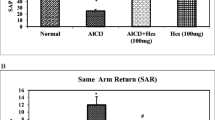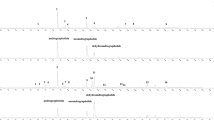Abstract
Asiatic acid (AA), a triterpenoid present in Centella asiatica, possesses the ability to cross blood brain barrier and received considerable attention for its neuroprotective role. We have reported the benefit of AA against aluminum chloride (AlCl3)-induced amyloid pathology, enhanced acetylcholine esterase (AChE) activity, and inflammation in Alzheimer’s disease (AD) like model rats. Based on that, to find the exact mechanism of action of AA, the present study was designed to evaluate the oxidative stress, tau pathology, apoptosis, and Akt/GSK3β signaling pathway on AlCl3-induced neurotoxicity in Wistar rats. AD-like pathology was induced by oral administration of AlCl3 (100 mg/kg b.w.) for 6 weeks, which demonstrated a significant reduction in spatial memory performance, anxiety, and motor dysfunction and diminished the expression of cyclin-dependent kinase 5 (CDK 5-enzyme implicated in the phosphorylation of tau proteins), pTau, oxidative stress, and apoptosis, whereas oral ingestion of AA (75 mg/kg b.w.) for 7 weeks attenuated the above-said indices, which could be by activating Akt/GSK3β pathway. Current results suggested that AA could be able to modulate various pathological features of AD and could hold promise in AD treatment.












Similar content being viewed by others
References
Abdel-Aal RA, Assi AA, Kostandy BB (2011) Rivastigmine reverses aluminum-induced behavioral changes in rats. Eur J Pharmacol 659:169–176
Ahmad Rather M, Justin Thenmozhi A, Manivasagam T, Nataraj J, Essa MM, Chidambaram SB (2018a) Asiatic acid nullified aluminium toxicity in in vitro model of Alzheimer’s disease. Front Biosci 10:287–299
Ahmad Rather M, Justin Thenmozhi A, Manivasagam T, Dhivya Bharathi M, Essa MM, Guillemin GJ (2018b) Neuroprotective role of Asiatic acid in aluminium chloride induced rat model of Alzheimer’s disease. Front Biosci 10:262–275
Al-Hashem F (2009) Camel’s milk protects against aluminum chloride induced toxicity in the liver and kidney of white albino rats. Am J Biochem Biotechnol 5:98–108
Aluise CD, Robinson RA, Beckett TL, Murphy MP, Cai J, Pierce WM, Markesbery WR, Butterfield DA (2010) Preclinical Alzheimer’s disease: brain oxidative stress, amyloid- beta peptide and proteomics. Neurobiol Dis 39:221–228
Beurel E, Jope RS (2006) The paradoxical pro- and anti-apoptotic actions of GSK3 in the intrinsic and extrinsic apoptosis signaling pathways. Prog Neurobiol 79:173–189
Blennow K, De Leon MJ, Zetterberg H (2006) Alzheimer’s disease. Lancet 368:387–403
Borsello T, Forloni G (2007) JNK signalling: a possible target to prevent neurodegeneration. Curr Pharm Des 13:1875–1886
Buraimoh AA, Ojo SA (2014) Effects of Aluminium chloride exposure on the body weight of Wistar rats. Ann Biol Res 2:66–73
Burke RE (2007) Inhibition of mitogen-activated protein kinase and stimulation of Akt kinase signalling pathways: two approaches with therapeutic potential in the treatment of neurodegenerative disease. Pharmacol Ther 114:261–277
Chaisawang P, Sirichoat A, Chaijaroonkhanarak W, Pannangrong W, Sripanidkulchai B, Wigmore P, Umka Welbat J (2017) Asiatic acid protects against cognitive deficits and reductions in cell proliferation and survival in the rat hippocampus caused by 5-fluorouracil chemotherapy. PLoS One 12:e0180650
Colovic MB, Krstic DZ, Lazarevic-Pasti TD, Bondzic AM, Vasic VM (2013) Acetylcholinesterase inhibitors: pharmacology and toxicology. Curr Neuropharmacol 11:315–335
Dhivya Bharathi M, Justin Thenmozhi A, Manivasagam T (2015) Protective effect of black tea extract against aluminium chloride-induced Alzheimer's disease in rats: a behavioural, biochemical and molecular approach. J Funct Foods 16:423–435
Feng Y, Xia Y, Yu G, Shu X, Ge H, Zeng K, Wang J, Wang X (2013) Cleavage of GSK-3β by calpain counteracts the inhibitory effect of Ser9 phosphorylation on GSK-3β activity induced by H2O2. J Neurochem 126:234–242
Guo C, Yin Y, Duan J, Zhu Y, Yan J, Wei G, Guan Y, Wu X, Wang Y, Xi M, Wen A (2015) Neuroprotective effect and underlying mechanism of sodium danshensu [3-(3,4-dihydroxyphenyl) lactic acid from Radix and Rhizoma Salviae miltiorrhizae - Danshen] against cerebral ischemia and reperfusion injury in rats. Phytomedicine 22:283–289
Hashimoto R, Nakamura Y, Komai S, Kashiwagi Y, Tamura K, Goto T, Aimoto S, Kaibuchi K, Shiosaka S, Takeda M (2000) Site-specific phosphorylation of neurofilament-L is mediated by calcium/calmodulin-dependent protein kinease II in the apical dendrites during long-term potentiation. J Neurochem 75:373–382
Heikkila RE, Cabbat FS, Manzino L, Duvoisin RC (1984) Effects of 1-methyl-4-phenyl-1,2,5,6-tetrahydropyridine on neostriatal dopamine in mice. Neuropharmacology 23:711–713
Hsu YL, Kuo PL, Lin LT, Lin CC (2005) Asiatic acid, a triterpene, induces apoptosis and cell cycle arrest through activation of extracellular signal-regulated kinase and p38 mitogen-activated protein kinase pathways in human breast cancer cells. J Pharmacol Exp Ther 313:333–344
Inamdar PK, Yeole RD, Ghogare AB, de Souza NJ (1996) Determination of biologically active constituents in Centella asiatica. J Chromatogr A 742:127–130
Iqbal K, Liu F, Gong CX (2016) Tau and neurodegeneration disease: the story so far. Nat Rev Neurol 12:15–27
Ji L, Chauhan A, Wegiel J, Essa MM, Chauhan V (2009) Gelsolin is proteolytically cleaved in the brains of individuals with Alzheimer’s disease. J Alzheimers Dis 18:105–111
Justin Thenmozhi A, William Raja TR, Janakiraman U, Manivasagam T (2015) Neuroprotective effect of hesperid in on aluminium chloride induced Alzheimer’s disease in Wistar rats. Neurochem Res 40:767–776
Justin Thenmozhi A, Dhivya bharathi M, William Raja TR, Manivasagam T, Essa MM (2016a) Tannoid principles of Emblica officinalis renovate cognitive deficits and attenuate amyloid pathologies against aluminum chloride induced rat model of Alzheimer’s disease. Nutr Neurosci 19:269–278
Justin Thenmozhi A, Dhivyabharathi M, Manivasagam T, Essa MM (2016b) Tannoid principles of Emblica officinalis attenuated aluminum chloride induced apoptosis by suppressing oxidative stress and tau pathology via Akt/GSK-3βsignaling pathway. J Ethnopharmacol 194:20–29
Justin Thenmozhi A, William Raja TR, Manivasagam T, Janakiraman U, Essa MM (2017) Hesperidin ameliorates cognitive dysfunction, oxidative stress and apoptosis against aluminium chloride induced rat model of Alzheimer’s disease. Nutr Neurosci 20:360–368
Khotimah H, Riawan W, Kalsum U, Widodo MA, Kishida M (2010) Neuroprotective effect of Pegagan leaf (CeA): induction of brain derived neurotrophic factor (BDNF) production, TNFa, BCL2 expression and apoptosis on rat pup neuronal cells in vitro. In The 5th International Student Conference on Advanced Science and Technology Japan: Kumamoto University 15–16
Kumar MHV, Gupta YK (2003) Effect of Centella asiatica on cognition and oxidative stress in an intracerebroventricular streptozotocin model of Alzheimer’s disease in rats. Clin Exp Pharmacol Physiol 30:336–342
Kumar V, Bal A, Gill KD (2009a) Susceptibility of mitochondrial superoxide dismutase to aluminium induced oxidative damage. Toxicology 255:117–123
Kumar A, Dogra S, Prakash A (2009b) Protective effect of curcumin (Curcuma longa), against aluminium toxicity: possible behavioral and biochemical alterations in rats. Behav Brain Res 205:384–390
Kumar A, Prakash A, Dogra S (2011) Neuroprotective effect of carvedilol against aluminium induced toxicity: possible behavioral and biochemical alterations in rats. Pharm Rep 63:915–923
Lee MK, Kim SR, Sung SH, Lim D, Kim H, Choi H, Park HK, Je S, Ki YC (2000) Asiatic acid derivatives protect cultured cortical neurons from glutamate-induced excitotoxicity. Res Commun Mol Pathol Pharmacol 108:75–86
Lee YS, Da-Qing J, Sung-Mok B, Lee ES, Kim JA (2003) Inhibition of ultraviolet-A-modulated signaling pathways by asiatic acid and ursolic acid in HaCaT human keratinocytes. Eur J Pharmacol 476:173–178
Lee G, Thangavel R, Sharma VM, Litersky JM, Bhaskar K, Fang SM, Do LH, Andreadis A, Van Hoesen G, Ksiezak-Reding H (2004) Phosphorylation of tau by fyn: implications for Alzheimer’s disease. J Neurosci 24:2304–2312
Loganathan C, Thayumanavan P (2018) Asiatic acid prevents the quinolinic acid-induced oxidative stress and cognitive impairment. Metab Brain Dis 33:151–159
Manyam BV (1999) Dementia in Ayurveda. J Altern Complement Med 5:81–88
Masoko P, Picard J, Howard RL, Mampuru LJ, Eloff JN (2010) In vivo antifungal effect of Combretum and Terminalia species extracts on cutaneous wound healing in immunosuppressed rats. Pharm Biol 48:621–632
Mushtaq G, Greig HN, Anwar F, Al-Abbasi FA, Zamzami MA, Al-Talhi HA, Kamal MA (2016) Neuroprotective mechanisms mediated by CDK5 inhibition. Curr Pharm Des 22:527–534
Nataraj J, Manivasagm T, Justin Thenmozhi A, Essa MM (2017) Neuroprotective effect of asiatic acid, a triterpene of Centella asiatica against chronic 1-methyl 4-phenyl 1, 2, 3, 6-tetrahydropyridine hydrochloride/probenecid mouse model of Parkinson’s disease: the role of MAPK, PI3K-Akt-GSK3β and mTOR signaling pathways. Neurochem Res 42:1354–1365
Oguz EO, Enli YS¸ Ahin B, Gönen C, Turgut G (2012) Aluminum sulfate exposure increases oxidative stress and suppresses brain development in Ross broiler chicks Med Sci Monit 18: 103–108
Pap M, Cooper GM (1998) Role of glycogen synthase kinase-3 in the phosphatidylinositol 3-kinase/Akt cell survival pathway. J Biol Chem 273:19929–19932
Pittella F, Dutra RC, Junior DD, Lopes MT, Barbosa NR (2009) Antioxidant and cytotoxic activities of Centella asiatica (L) Urb. Int J of Mol Sci 10:3713–3721
Plucinska K, Crouch B, Koss D, Robinson L, Siebrecht M, Riedel G, Platt B (2014) Knock-in of human BACE1cleaves murine APP and reiterates Alzheimer-like phenotypes. J Neurosci 34:10710–10728
Prakash A, Kumar A (2009) Effect of N-acetyl cysteine against aluminium-induced cognitive dysfunction and oxidative damage in rats. Basic Clin Pharmacol Toxicol 105:98–104
Prema A, Thenmozhi AJ, Manivasagam T, Essa MM, Akbar MD, Akbar M (2016) Fenugreek seed powder nullified aluminium chloride induced memory loss, biochemical changes, Aβ burden and apoptosis via regulating Akt/GSK3β signaling pathway. PLoS One 11:e0165955
Prema A, Justin Thenmozhi A, Manivasagam T, Mohamed Essa M, Guillemin GJ (2017) Fenugreek seed powder attenuated aluminum chloride-induced tau pathology, oxidative stress, and inflammation in a rat model of Alzheimer’s disease. J Alzheimers Dis 60:209–220
Rao MK, Muddanna SR, Gurumadhva SR (2007) Treatment with centella asiatica (Linn) fresh leaf extract enhances learning ability and memory retention power in rats. Neuroscience 12:236–241
Takashima A (2006) GSK-3 is essential in the pathogenesis of Alzheimer’s disease. J Alzheimers Dis 9:309–317
Tsao SM, Yin MC (2015) Antioxidative and antiinflammatory activities of asiatic acid, glycyrrhizic acid, and oleanolic acid in human bronchial epithelial cells. J Agric Food Chem 63:3196–3204
Umka Welbat J, Sirichoat A, Chaijaroonkhanarak W, Prachaney P, Pannangrong W, Pakdeechote P, Sripandikulchai B, Wigmore P (2016) Asiatic acid prevents the deleterious effects of valproic acid on cognition and hippocampal cell proliferation and survival. Nutrients 18:5
Wei L, Chen Q, Guo A, Fan J, Wang R, Zhang H (2018) Asiatic acid attenuates CCl4-induced liver fibrosis in rat by regulating the PI3K/AKT/mTOR and Bcl-2/Bax signaling pathways. Int Immunopharmacol 60:1–8
Xu MF, Xiong YY, Liu JK, Qian JJ, Zhu L, Gao J (2012) Asiatic acid, a pentacyclic triterpene in Centella asiatica, attenuates glutamate- induced cognitive deficits in mice and apoptosis in SHSY5Y cells. Acta Pharmacol Sin:33, 578–587
Zhang X, Wu J, Dou Y, Xia B, Rong W, Rimbach G, Lou Y (2012) Asiatic acid protects primary neurons against C2-ceramide-induced apoptosis. Eur J Pharmacol:679, 51–659
Zhao H, Sapolsky RM, Steinberg GK (2006) Phosphoinositide-3-kinase/akt survival signal pathways are implicated in neuronal survival after stroke. Mol Neurobiol 34:249–270
Author information
Authors and Affiliations
Corresponding author
Ethics declarations
Conflict of Interest
The authors declare that they have no conflict of interest.
Additional information
Publisher’s Note
Springer Nature remains neutral with regard to jurisdictional claims in published maps and institutional affiliations.
Rights and permissions
About this article
Cite this article
Ahmad Rather, M., Justin-Thenmozhi, A., Manivasagam, T. et al. Asiatic Acid Attenuated Aluminum Chloride-Induced Tau Pathology, Oxidative Stress and Apoptosis Via AKT/GSK-3β Signaling Pathway in Wistar Rats. Neurotox Res 35, 955–968 (2019). https://doi.org/10.1007/s12640-019-9999-2
Received:
Revised:
Accepted:
Published:
Issue Date:
DOI: https://doi.org/10.1007/s12640-019-9999-2




